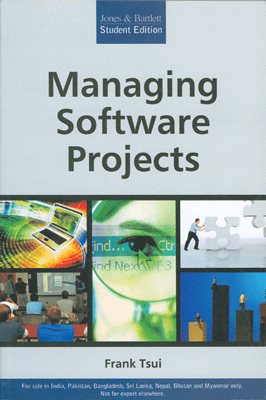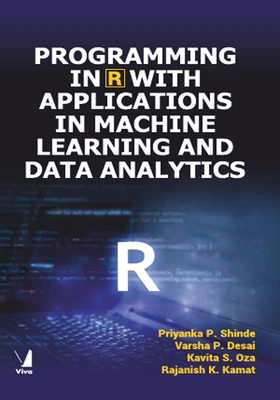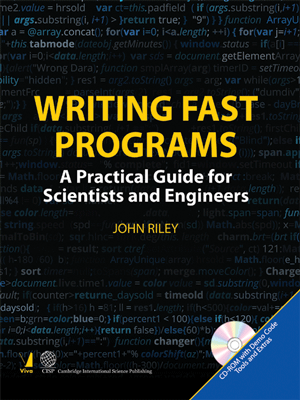Managing Software Projects
Managing Software Projects
₹292.50 ₹325.00 Save: ₹32.50 (10%)
Go to cartISBN: 9789380108803
Bind: Paperback
Year: 2017
Pages: 366
Size: 153 x 235 mm
Publisher: Jones & Bartlett Learning
Published in India by: Jones & Bartlett India
Exclusive Distributors: Viva Books
Sales Territory: India, Nepal, Pakistan, Bangladesh, Sri Lanka
Description:
Managing Software Projects is a book for software engineering students and project management professionals in the IT and software industry. It focuses on four phases of management—planning, organizing, monitoring, and adjusting (POMA)and tailors them to application on software projects. The tasks and techniques utilized in each of the POMA management phases are discussed with specific software engineering and IT related examples. Drawing from years of experience in the industry, the author presents material within a framework of real examples and exercises that help readers apply new concepts to everyday situations. Featuring outstanding pedagogical features for students as well as full instructor's resource, Managing Software Projects is the ideal text for course in this growing field.
Key Features:
- Emphasizes POMA (Planning, Organizing, Monitoring, and Adjusting) as a step-by-step framework for studying software project management. POMA is discussed as a separate management cycle for software projects rather than as a small part of the software development life cycle.
- Real-world examples and exercises illustrate important concepts as they are applied to actual software projects. The author pulls from his extensive personal experience managing large, complex software projects at IBM, MARCAM, Metamor/PSINet, and RiverLogic.
- An Additional Skills section includes four chapters ? Project Team, Change Control, Task Scheduling, and Effort Estimation ? that allow instructors to tailor the course to the desired emphasis.
- Review and Reinforcement throughout, including
- Exercises at the end of each chapter include questions that go beyond rehearsing material covered in the chapter and encourage students to think critically .
- Key concepts sections offer students a quick review of the major issues discussed
Target Audience:
Managing Software Projects is a book for Software Engineering Students and Project Management Professionals in the IT and software industries.
Contents:
INTRODUCTION: WHAT IS SOFTWARE PROJECT MANAGEMENT? • Software Project • Software Artifacts • Code Versus Noncode Software Artifacts • Software Engineering • Software Process and Methodology • Components of Software Engineering • Software Product Life Cycle • The Software Project Management Process • POMA: The Phases of Software Project Management • Planning • Organizing • Monitoring • Adjusting • POMA at All Management Levels • Key Concepts • Exercises • Suggested Reading
PART ONE: SOFTWARE PROJECT PLANNING (FOMA) • A Team Effort • Plan Content • Levels of Planning • Quick Estimate • Comprehensive Plan
Chapter 1: Project Content and Deliverables • Gathering and Analyzing Project Requirements • Potential Pitfalls. • Completing the Requirements Specification as a Separate Project • General Requirements Management Activities • Types of Requirements • Project Deliverables • Project Needs and Their Characterization • Review and Approval of Requirements • Internal Requirements Generation and Prioritization • The Prioritization Process • Role of the Software Product Management Board • Quick Estimates and High-Level Requirements • Key Concepts • Exercises • Suggested Reading
Chapter 2: Task Analysis • Work Breakdown Structure • Steps in the WBS • WBS in Practice: Introduction to and Example • Deliverable 1: Executable Code • Deliverable 2: Help Text, Usage, and Reference Information • WBS Task Refinement • Activities and Sub deliverables for Deliverable • Task Sequencing and Sequence Diagram • WBS Time and Resource Assignments • Units of Task Measurement • Task Estimates and Task Assignments • Milestones • WBS Iteration and Acceptance • Key Concepts • Exercises • Suggested Reading
Chapter 3: Goals and Measurements • Project Attributes • Preliminary Goals • Measurable, Trackable, Validatable, and Verifiable Goals • Metrics and Measurements: An Overview • Deliverable-Related Metrics and Measurements • Metrics and Measurements Example I: The Quality Attribute • Complex Attributes • Project- and Process-Related Metrics and Measurements • Metrics and Measurements Example II: The Schedule Integrity Attribute • Interrelated Attributes • Influencing Downstream Phases • Key Concepts • Exercises • Suggested Reading
Chapter 4: Project Resource Planning • Planning for the Three Types of Resources • Human Resources • Skills Matrix • Hiring Plan • People Hiring Matrix and the Recruiting Plan • People as Human Capital • Processes and Methodologies • Software Project Phases • Requirements Process Planning • Design Process Planning • Implementation and Programming Process Planning • Test Process Planning • Product Release Process Planning • Other Process Planning Considerations • Tools and Equipment • Combining the Resources • Outsourcing Versus Insourcing • Key Concepts • Exercises • Suggested Reading
Chapter 5: Risk Analysis and Planning • Risk Definition • Risk Identification • Identifying and Listing the Anticipatable Risks • Risk Prioritization • Prioritization by Recovery Cost • Types of Recovery Cost Prioritization Prioritization by Risk Value • Risk Mitigation • Cost-Based Mitigation • Cost of Mitigation • Probability of Success • Mitigation Value Cost • Fixed Budget for Risk Mitigation • Risk Removal and the Risk Plan • Key Concepts • Exercises • Suggested Reading
PART TWO: ORGANIZING AND PREPARING (POMA) • Organizing • Human Resources • Processes, Methodologies, and Tools • Goals and Measurements
Chapter 6: Human Resources • Software Project Organization: An Overview • Software Development Structures • General Organizational Structure • Refining the General Organizational Structure • Matrix Versus Hierarchical Orientation • Refining the General Organizational Structure II: Functional Orientation • Refining the General Organizational Structure III: A Highly Specialized Organization • Software Support Structures • Recruiting and Hiring Software Personnel • Recruiting • Hiring • Bringing People on Board • Key Concepts • Exercises • Suggested Reading
Chapter 7: Processes, Methodologies, and Tools • Processes • Process Map • Process Flow • Configuration Management • Processes and Subprocesses • Process Introduction and Education • Methodologies • Methodology Definition • Methodology Preparation • Tools • Tool Identification and Preparation • Tool Selection • Tool Usage and Preparation • Key Concepts • Exercises • Suggested Reading
Chapter 8: Goals and Measurements: Preparations and Costs • Transforming Goals and Measurements • Clarifying Definitions of Goals and Measurements • Decomposing the Ease-of-Use Example • Potentially Misleading Measurements • Building a Measurement Operational Plan • Embracing the Measurement Scheme • Participating in Goal and Measurement Preparations • Goal Attainability • Measurement Costs • Key Concepts • Exercises • Suggested Reading ?
PART THREE: SOFTWARE PROJECT MONITORING (POMA) • The Role of Monitoring in Software Project Management • Monitoring: A Three-Part Operation
Chapter 9: Collecting Project Information • Formal Data Gathering and Monitoring • Activity-Based Monitoring • Attribute-Based Monitoring • Macro and Micro Levels of Monitoring • Monitoring Completeness of Function • Monitoring Quality • Monitoring the Budget • Data Collection Schedule • Formal Project Status Meetings • Informal Data Gathering and Monitoring • Physically Collocated Environment • Physically Remote Environment • Establishing Trust • Key Concepts • Exercises • Suggested Reading
Chapter 10: Analysis and Evaluation of Information • Reliable, Accurate, and Valid Data • Distribution of Data • Example I: Skew of the Distribution • Example II: Range of Data Values • Example III: Data Trends • Centrality and Dispersion • Average Value • Median Value • Standard Deviation and Control Charts • Data Smoothing: Moving Averages • Data Correlation • Normalization of Data • ? Key Concepts • Exercises • Suggested Reading
Chapter 11: Presenting and Communicating Data • Sharing Information • Communicating Time-Related Status • Tabular Formats • Bar-Chart Formats • Communicating Control-Related Status • Other Common Data Representation Formats • Pie Charts • Histograms • Selecting a Data Representation Format • Key Concepts • Exercises • Suggested Reading
PART FOUR: ADJUSTMENTS AND ACTIONS (POMA)
Chapter 12: Planned and Unplanned Adjustments and Actions • Taking Actions with Urgency • Steps in Taking Urgent Action • Change Management • Planned Adjustments • The Planned Adjustment Decision-Making Process and Targets • Making Planned Adjustments to Functionality, Resources and Schedule • Unplanned Adjustments • Functionality Changes • Resource Changes • Schedule Changes • Key Concepts • Exercises • Suggested Reading
Chapter 13: Release Management Council • The Team Management Approach • Formulating a Release Management Council • The Release Management Mode of Operation • Conducting the Release Management Council • Meetings • Making Decisions about Product Release • Key Concepts • Exercises • Suggested Reading
PART FIVE: ADDITIONAL SKILLS
Chapter 14: The Project Team • Project Team Life Cycle • Team Formation • Technical Software Skills • Soft Skills and Personal Traits • Team Development • Team Maintenance • Rewarding Team Members • Punishing Team Members • Handling Team Attrition • Team Member Growth • Key Concepts • Exercises • Suggested Reading
Chapter 15: Change Control • An Example Change Request Process • Change Impact Analysis • Change Request Denial or Acceptance • Cumulative Effects of Changes • Key Concepts • Exercises • Suggested Reading
Chapter 16: Task Scheduling • Task Sequence and Effort Representation • Critical Versus Noncritical Paths • Forward- and Backward-Pass Scheduling of Tasks • Chapter • Slack Times • Total Slack Time • Free Slack Time • Improving Estimations: The Program Evaluation and Review Technique • Reducing Schedules: The Critical Path Method • Creating a Calendar Schedule • Exercises • Suggested Reading
Chapter 17: Effort Estimation • Informal Effort Estimation • General Estimation Model • The Size Factor • Other Factors Affecting Project Effort • The COCOMO Effort Estimation Model • Identify the Nominal Mode of Development • Estimate the Size of the Project • Review and Assign Values to the Cost Drivers • Calculate the Effort Estimate ?The Continuing Evolution of COCOMO • Key Concepts • Exercises • Suggested
About the Author:
Frank Tsui-Southern Polytechnic State University. Professor Tsui has more than 30 years of experience in the Software and IT industry. He is currently a full time faculty member of the School of Computing and Software Engineering at SPSU. He has also been an adjunct faculty at both Georgia Tech and Southern Polytechnic State University(SPSU). His experience includes compiler writing for RCA, business applications programming for BlueCross BlueShield, operating system development and software product management with IBM Corp., Director of Software Development with MARCAM, Vice President of Technology with PSInet/Metamor, and Chief Technology Officer with RiverLogic Inc. Several well known industry software products were developed under Tsui's guidance: IBM's CMAS construction package, IBM's MVS/JES3 Operating System, IBM's MAPICS ERP (Second Release) package, and IBM's EDI package. He is actively involved with the software industry and is especially interested in: Development Processes, Configuration Management, Product and Service Quality, Measurements and Metrics, Testing and Validation.







